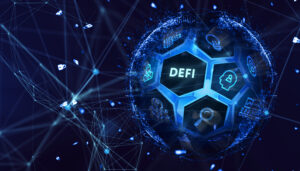Since the invention of money, banks have stood out as the “superpowers” of the financial industry. For instance, in 2015, following the Great Recession, the five most prominent financial institutions in America controlled more than 45% of the industry’s total assets. Today, consumers require bank approval for everything- from securing mortgage loans to carrying out daily transactions.
In this article, we shall look at the traditional financial industry, define decentralized finance, discuss why it is the future of finance, and elaborate on how defi works. We will also look at the practical use cases of defi, review the current state of the industry, and finally end with the outlook.
Traditional finance
The traditional financial system remains fully centralized. A few individuals exercise the right to manage and control the flow and supply of money, stocks, bonds, debt, and interest. Access to banking services is not open to everybody, and for people to access them, they must pay for the right to use them. People keep their money in financial institutions, which banks invest, earn interests, and charge customers fees for holding money on their behalf.
Besides, the traditional financial industry sometimes overlooks people in the current economy. A study conducted by the Federal Deposit Insurance Corp found that 25% of Americans are either unbanked or underbanked. Globally, the figure rises to 69% of families. There is a need within the financial market to leverage the power of blockchain and enable people to take greater control of their identity and assets.
Customer data is also insecure when stored by large central institutions. In 2019, Capital One experienced a hacker attack that exposed the personal information of more than 100 million customers. The tendency of storing personal data in a single central location increases hacking attempts dramatically, but despite this, banks require customers to provide their personal information daily.
Lastly, lately, banks are challenged with meeting customers’ high expectations for fast and effective online banking processes, while also taking extra care to minimize online fraud and fulfill the increasingly strict regulatory measures. As a result, banks make slow and calculated steps concerning compliant storage of personally identifiable information (PII) as they strive to meet the high need for online banking services.
What is defi?
Defi stands for decentralized finance and its primary goal is to hand everyone access to traditional financial services by offering a borderless, permissionless, and uncensored financial service ecosystem powered by blockchain technology. Traditional financial applications like trading, lending, borrowing, payments, and insurance can be put into smart contracts and executed by Decentralized Applications (DApps) to create a Peer-to-Peer (P2P) financial system.
With defi, people will have full access to financial services and total control of their financial assets. Besides, since most of the code used by these DApps are in Ethereum smart contracts, they can be accessed by anyone who knows how to read and write.
The main application of defi is: investors deposit their digital currencies into a smart contract, and when someone else borrows the money, they earn interest. So basically, the smart contracts connect borrowers and lenders and also allocates the interest accrued.
Key differences between defi and traditional Banks
Banks are controlled by a centralized governing establishment, while defi applications operate on smart contracts, which ensure that these DApps operate without third parties.
Since dapps are built on public blockchains, their codes are transparent, and anyone can access them. On the other hand, the traditional banking system is totally opaque.
Why decentralization is the future of finance
Blockchain is an innovative solution to the challenges faced by consumers whose needs are not satisfied by the traditional banking system. The technology creates a more direct route to people, eliminating the involvement of third parties and bringing more efficiency to consumers. Generally, decentralization through blockchain provides a more secure and accessible banking system.
There are three primary aspects of a decentralized financial system that hand it an added advantage over the traditional banking system. Decentralized finance via public blockchain brings the following benefits:
- Open: anyone can access it globally
- Distributed: data is kept in thousands of computers, adding an extra layer of security
- Trustless: there is no third party to request verification documents.
The advantages of blockchain- faster, cost-effective, easily accessible- are evident for financial institutions. The technology allows anyone with an internet connection and a connecting device computer to access banking services- causing a significant decrease in the unbanked population.
How does defi work?
Most defi services are web-based platforms that run on the Ethereum network through smart contracts. There are several applications of defi services, borrowing, and lending is the most popular one.
Borrowing and lending
Decentralized borrowing and lending are the most common use cases of the defi system. The elimination of third parties minimizes counterparty risk, making borrowing and lending cheaper, faster, and more accessible. Decentralized borrowing and lending have the following benefits over the conventional credit system:
- Instant transaction processing
- Ability to collateralize digital assets
- No credit checks
- Potential standardization in the future
Monetary banking services
Issuance of stablecoins, mortgages, and insurance are categorized under this group. The issuance of stablecoins has become a popular discussion point in the cryptocurrency space. Stablecoins are digital currencies that issuers design to offer measurable stability and security.
One of the major hindrances of mainstream adoption of digital currencies is price fluctuation. The crypto market is quite impractical for daily commerce. But, a price-stable, decentralized digital token will definitely solve this problem. Stablecoins retain their stability through pegs. A peg fixes the value of a currency in a programmed ratio to a more stable and globally predominant currency.
Decentralized exchanges (DEX)
A DEX is probably the most promising defi use cases. In a standard exchange, you must trust an intermediary (the exchange) to store your digital assets. In a DEX, users can connect with other crypto users and transact directly. DEXs typically have lower trading charges compared to centralized exchanges, because they need less maintenance. Other than DEX, other use cases involved in this field include the formation of derivatives, synthetic assets, decentralized prediction markets, and many more.
Popular defi platforms
Dharma
Dharma uses a partially-centralized model where Ethereum-based P2P lending/borrowing platform that supports DAI, ETH, and USDC for collateralization. The average collateral ratio is 210%, and each coin has its own interest rate. Dharma permits users to lend and borrow assets for three months at a fixed interest rate. The lending and borrowing rates are equal.
Since Dharma is a non-custodial platform, it serves its customers manually. A person requests to lend his assets and then waits for a borrower to match his request. Therefore, it is more of a direct match-making type of platform.
Compound
Compound is an Ethereum-based money market protocol for various digital tokens. The platform supports BAT, DAI. ETH, USDC, REP, and ZRX tokens. Each token market is linked to the cToken (cBAT), which acts as an intermediary asset for all transactions, and lenders earn interest via the cTokens, making it a liquidity pool type of P2P platform.
Unlike Dharma, the Compound platform has no fixed interest rate- instead, the platform uses real-time market dynamics to determine interest rates. For instance, it will increase when there is a high demand from borrowers and drop when there is a top lending trend. Typically, the lending interest rate is lower than the borrowing rate to provide more liquidity.
MakerDao
MakerDao’s Dai token is probably the most popular and widely used synthetics in defi. The platform supports DAI and Ethereum assets and allows users to borrow DAI, which has a soft peg in USD, by holding ETH tokens in reserve in Collateralized Debt Position (CDP). Maker requires overcollateralized loans — above 150%. Additionally, there are several methods for stablecoins collateral to retain their peg value against fiat.
Unlike P2P systems where existing tokens are transferrable, the protocol actively issues assets from reserve pools in MakerDao. The Maker token (MKR) allows people to take part in the operational earnings through “governance fees,” which act as the interest rate for the platform.
Defi currently
The defi sector is in its early stages, as the entire blockchain industry is. We could say that it is still in a trial phase, even though we already have more than $834 million locked in defi networks. Nonetheless, it is the fastest-growing field in decentralized services, with over 40,000 monthly users and a rising number of startup projects.
MakerDAO dominates the lending field, though platforms like Compound are catching up at a fast rate. As mentioned earlier, the lending domain is the most popular application of defi, but it is not the only application. Decentralized marketplaces are another application that experienced significant growth last year; Uniswap exchange being the highest trading volume in 2019, at $390 million.
Generally, defi applications have not attained massive adoption and remain the domain of crypto enthusiasts. Blockchain enthusiasts anticipate that the startups and the entire industry will keep growing and appeal to investors and capital beyond the scope of the current cryptocurrency industry.
Challenges for defi and the future
The defi sector still requires more work and patience. One of the primary problems of lending networks is the over-collateralization of products, implying that people cannot access the asset they do not have since there is currently no credit scoring or shared collateral.
Among the several issues that defi faces, having all the logic in smart contracts and each transaction being irreversible on the blockchain will not help if fraudulent individuals want to take advantage of bugs on the platforms. There is an increasing number of companies auditing defi smart contracts and offering insurance, if the contracts fail for any reason, to prevent fraudulent activities.
Another challenge of using a blockchain network, particularly Ethereum, is transaction fees, like gas charges. Every time users send ether or any ERC20 token to any wallet, they have to pay the gas fees of the Ethereum network. Though these charges are still lower than what users pay in traditional finance, it is still a factor to consider when operating on these types of platforms.
In conclusion, there is a bright future for defi. Once defi has overcome the challenges of user experience design and the trust of the masses, we will see these protocols as an essential part of the Internet. Just like TCP/IP is the network communication protocol, defi will be for P2P finance protocol. Decentralized digital assets and access to uncensored financial services will become the new norm.
Related posts:
- How blockchain is bringing gamification to every industry
- How enterprise blockchain applications can improve your firm’s internal processes
- Blockchain use cases in fintech
- Use cases for blockchain. How to build a seamless Stellar peer-to-peer payments app
- Blockchain e-commerce is keeping the secondary luxury market honest




